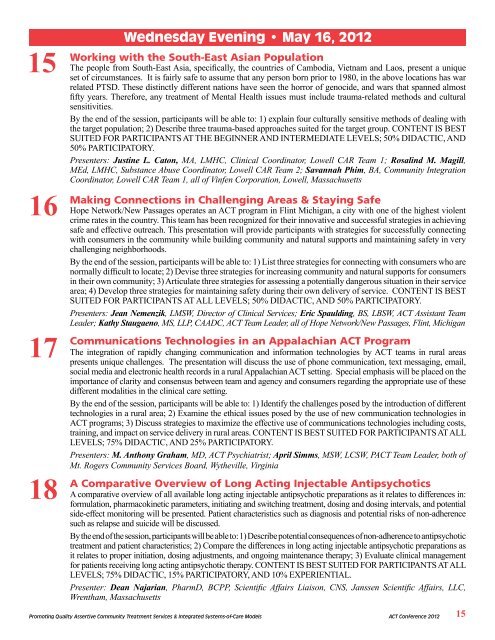2012 ACT Conference Brochure Online - Assertive Community ...
2012 ACT Conference Brochure Online - Assertive Community ...
2012 ACT Conference Brochure Online - Assertive Community ...
Create successful ePaper yourself
Turn your PDF publications into a flip-book with our unique Google optimized e-Paper software.
15<br />
16<br />
17<br />
18<br />
Wednesday Evening • May 16, <strong>2012</strong><br />
Working with the South-East Asian Population<br />
The people from South-East Asia, specifically, the countries of Cambodia, Vietnam and Laos, present a unique<br />
set of circumstances. It is fairly safe to assume that any person born prior to 1980, in the above locations has war<br />
related PTSD. These distinctly different nations have seen the horror of genocide, and wars that spanned almost<br />
fifty years. Therefore, any treatment of Mental Health issues must include trauma-related methods and cultural<br />
sensitivities.<br />
By the end of the session, participants will be able to: 1) explain four culturally sensitive methods of dealing with<br />
the target population; 2) Describe three trauma-based approaches suited for the target group. CONTENT IS BEST<br />
SUITED FOR PARTICIPANTS AT THE BEGINNER AND INTERMEDIATE LEVELS; 50% DID<strong>ACT</strong>IC, AND<br />
50% PARTICIPATORY.<br />
Presenters: Justine L. Caton, MA, LMHC, Clinical Coordinator, Lowell CAR Team 1; Rosalind M. Magill,<br />
MEd, LMHC, Substance Abuse Coordinator, Lowell CAR Team 2; Savannah Phim, BA, <strong>Community</strong> Integration<br />
Coordinator, Lowell CAR Team 1, all of Vinfen Corporation, Lowell, Massachusetts<br />
Making Connections in Challenging Areas & Staying Safe<br />
Hope Network/New Passages operates an <strong>ACT</strong> program in Flint Michigan, a city with one of the highest violent<br />
crime rates in the country. This team has been recognized for their innovative and successful strategies in achieving<br />
safe and effective outreach. This presentation will provide participants with strategies for successfully connecting<br />
with consumers in the community while building community and natural supports and maintaining safety in very<br />
challenging neighborhoods.<br />
By the end of the session, participants will be able to: 1) List three strategies for connecting with consumers who are<br />
normally difficult to locate; 2) Devise three strategies for increasing community and natural supports for consumers<br />
in their own community; 3) Articulate three strategies for assessing a potentially dangerous situation in their service<br />
area; 4) Develop three strategies for maintaining safety during their own delivery of service. CONTENT IS BEST<br />
SUITED FOR PARTICIPANTS AT ALL LEVELS; 50% DID<strong>ACT</strong>IC, AND 50% PARTICIPATORY.<br />
Presenters: Jean Nemenzik, LMSW, Director of Clinical Services; Eric Spaulding, BS, LBSW, <strong>ACT</strong> Assistant Team<br />
Leader; Kathy Staugaeno, MS, LLP, CAADC, <strong>ACT</strong> Team Leader, all of Hope Network/New Passages, Flint, Michigan<br />
Communications Technologies in an Appalachian <strong>ACT</strong> Program<br />
The integration of rapidly changing communication and information technologies by <strong>ACT</strong> teams in rural areas<br />
presents unique challenges. The presentation will discuss the use of phone communication, text messaging, email,<br />
social media and electronic health records in a rural Appalachian <strong>ACT</strong> setting. Special emphasis will be placed on the<br />
importance of clarity and consensus between team and agency and consumers regarding the appropriate use of these<br />
different modalities in the clinical care setting.<br />
By the end of the session, participants will be able to: 1) Identify the challenges posed by the introduction of different<br />
technologies in a rural area; 2) Examine the ethical issues posed by the use of new communication technologies in<br />
<strong>ACT</strong> programs; 3) Discuss strategies to maximize the effective use of communications technologies including costs,<br />
training, and impact on service delivery in rural areas. CONTENT IS BEST SUITED FOR PARTICIPANTS AT ALL<br />
LEVELS; 75% DID<strong>ACT</strong>IC, AND 25% PARTICIPATORY.<br />
Presenters: M. Anthony Graham, MD, <strong>ACT</strong> Psychiatrist; April Simms, MSW, LCSW, P<strong>ACT</strong> Team Leader, both of<br />
Mt. Rogers <strong>Community</strong> Services Board, Wytheville, Virginia<br />
A Comparative Overview of Long Acting Injectable Antipsychotics<br />
A comparative overview of all available long acting injectable antipsychotic preparations as it relates to differences in:<br />
formulation, pharmacokinetic parameters, initiating and switching treatment, dosing and dosing intervals, and potential<br />
side-effect monitoring will be presented. Patient characteristics such as diagnosis and potential risks of non-adherence<br />
such as relapse and suicide will be discussed.<br />
By the end of the session, participants will be able to: 1) Describe potential consequences of non-adherence to antipsychotic<br />
treatment and patient characteristics; 2) Compare the differences in long acting injectable antipsychotic preparations as<br />
it relates to proper initiation, dosing adjustments, and ongoing maintenance therapy; 3) Evaluate clinical management<br />
for patients receiving long acting antipsychotic therapy. CONTENT IS BEST SUITED FOR PARTICIPANTS AT ALL<br />
LEVELS; 75% DID<strong>ACT</strong>IC, 15% PARTICIPATORY, AND 10% EXPERIENTIAL.<br />
Presenter: Dean Najarian, PharmD, BCPP, Scientific Affairs Liaison, CNS, Janssen Scientific Affairs, LLC,<br />
Wrentham, Massachusetts<br />
Promoting Quality <strong>Assertive</strong> <strong>Community</strong> Treatment Services & Integrated Systems-of-Care Models <strong>ACT</strong> <strong>Conference</strong> <strong>2012</strong> 15




